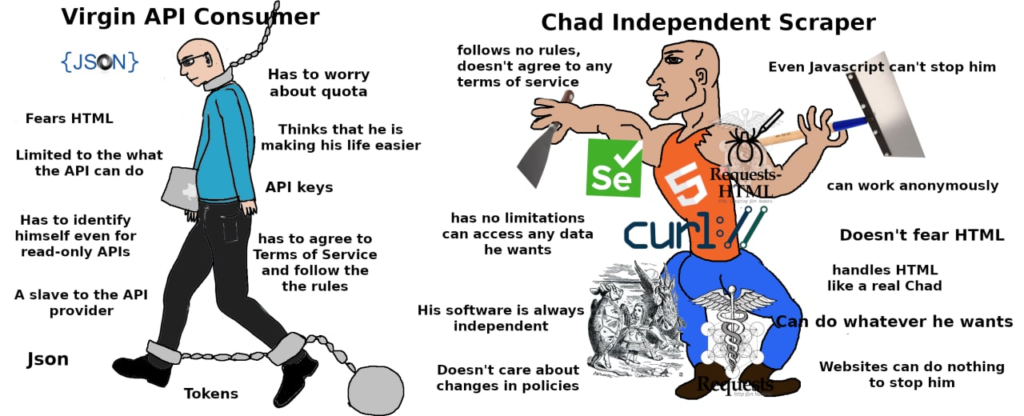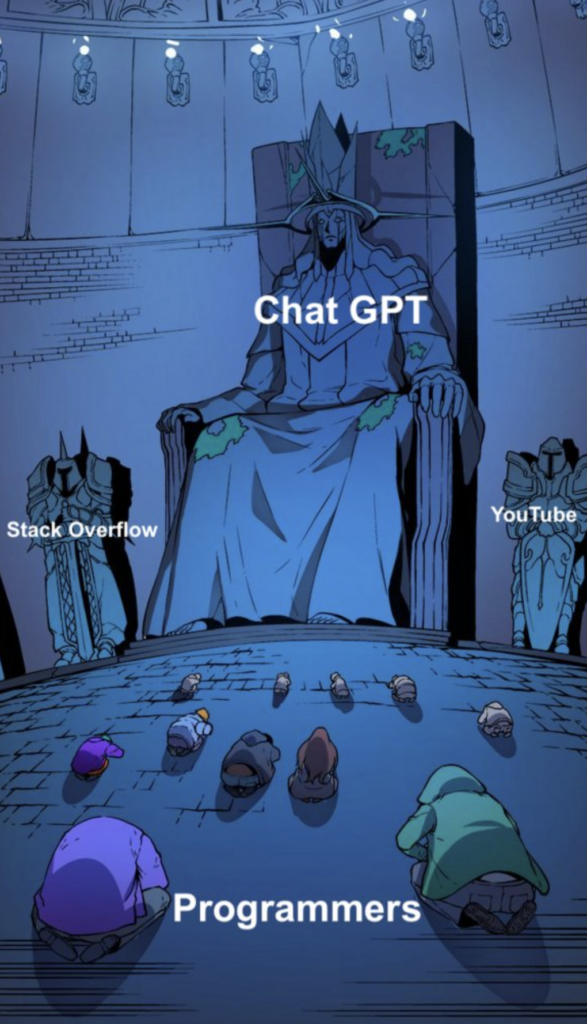Today we will present the financial results of Big Tech, so it will blow a little frosty…. the main topic, however, remains a look at how enthusiasts are reverse-engineering the games of our childhood.
1. Big Tech financial results explain recent wave of layoffs
The time has come for announcements of quarterly results for Q4 2022, and I’ll admit that as I usually treat such announcements as a curiosity, this time I was wildly intrigued as to what the BigTechs would also show. After all, many commentators have argued that the recent spate of layoffs was strongly anticipatory of what we would see in the accounting books. Until now, however, we could at best speculate, but now the cards are on the table, and unfortunately – they show that quite a few fears have been confirmed.
Let’s start with Alphabet, whose profits dropped 34% quarter-on-quarter, which shows how hard AdTech (well, let’s not lie, from a business point of view that’s what Google is) is flopping in a world of unraveling recession. Revenues are down, and the company’s Q4 growth is just 1% year-on-year. We are getting to such curiosities that Google’s fastest-growing branch is…. Granural, the company they bought that insures companies against excessive employee health care costs.

Let’s keep flying. Amazon’s situation (at least superficially looking) is even worse than Google’s – the last quarter of the year was admittedly a higher growth (9% year-on-year), but paid for by a drop in profits (from 14 billion to just 0.3 billion year-on-year). Other than that, you won’t find much interesting there, just a good explanation of the last quarter’s layoffs.
More interesting is the situation at Meta, where the announcement of quarterly results was associated with 20% increases in the company’s valuation. Are the results that good? Admittedly, revenue only fell by 4%, but profit was already down by half year-on-year. So what made the stock market react in such a way? Well, the company announced that it will use its outstanding capital in the treasury (because despite all the problems, let’s not forget that BigTechs sleep on money) to buy back its shares from the market for a sum of $40 billion. So this is another nod to investors, as are the announcements of a “year of efficiency,” something that has passed Mark Zuckerberg’s lips. What this efficiency will manifest itself in, we will find out soon enough. Probably don’t expect (as predicted last week) big increases in the Metaverse project – that one showed a nearly 5 billion operating loss in the quarter.
That’s it, ending this parade of weeping and gnashing of teeth, let’s take a look at Apple, for this company is always, in the end, a lark of good news and will probably bring some optimism to this review.

Apple also took a hard hit in Q4, scoring its worst quarter since 2016. For the first time in a long time (specifically, since 2019), the company shrank year-to-year. Worse hardware sales were to blame: iPhones (albeit to a much lesser extent than Samsung, for example), computers, and other gadgets. Only the iPad grew in this category. As usual, services also scored growth, and the company itself boasted a dizzying two billion active devices. Apple has recently begun to aggressively force returns to offices, and it will be interesting to see if we can expect further moves from the company. Currently, it is the only one of the listed players that has not announced mass layoffs, so as a “safe haven” it can afford to move more aggressively than its competitors on enforcing return-to-office.
As you can see, it wasn’t a good quarter, and it’s likely that many companies will be looking for new ways to generate profits in 2023, or further “optimizations” await us. After all, the likes of Twitter (which, as a private company, no longer has to share its quarterly results) announced that access to its API would become paid, causing the online community to revolt. Although I suspect that after the last quarter, Twitter is just 🤷♂️ to all that.

Sources
- Meta Revenue Falls 4% in Q4 as Facebook Hits 2 Billion Daily Users, Stock Pops 20%
- Google’s fastest-growing business is insuring companies against their workers’ health
- Google struggled to grow over the holidays despite ‘great momentum’ on YouTube and Pixels
- Twitter to end free access to its API in Elon Musk’s latest monetization push
- Apple cracking down to enforce its RTO policy

2. What does reverse engineering of old games give us?
This section will probably be of interest mainly to me and other Nintendo game fans – however, looking at the number of Nintendo Switch sold, I think there are quite a few of us.

Let’s start with an announcement – the fully working source code for Legend of Zelda: The Link to the Past, originally released for Super Nintendo consoles, has appeared on GitHub. While the topic is not new (the code on GitHub is already three months old), the whole thing was reported by NeoWin – one of the big technology portals, from where it made headlines in such publications as Kotaku and Nintendo Life. There, in turn, it has already been picked up by the strictly-technlogical part of the Internet. “The new” Link to the Past is written in C, and the whole thing has closed in a surprisingly sizable 80,000 lines of code.

What gives us access to the port code anyway? After all, using a ROM, such “Legend of Zelda: The Link to The Past” can be run seamlessly on any device that has an emulator? Well, it turns out that there are a ton of options for improving the game, such as the ability to support Widescreens, adding graphic filters, a map with more detail or faster loading times. There is also the possibility of fixing some of the bugs of the original (although here the game was highly polished anyway) and creating “native”, non-emulated console versions. For example, PlayStation Vita is full of ports of games that were never officially released for it. The legality of such projects is also surprising – as long as they don’t use official “assets” from the game (from experience – such as Sonic Mania on Vita requires the player to own the full version on another platform), it’s actually hard to put them to court.

And while we’re on the topic of Reverse Engineering, I’ll have two more interesting publications for you. First of all, I am a Kindle Reader user, so once I got my read on a text describing how to take apart Whispersync, the ebook transfer protocol created by Amazon for the device. The text Reverse engineer whispersync will take you step-by-step through the process, outlining the specific tools and commands used during it.
And if you want to learn more about Reverse Engineering as such, I suggest you <a href=”https://www.youtube.com/watch?v=9tZmSFjoOm4″>Computerphile’s publication, which is an accessible video that covers the topic well</a>.

Sources
- snesrev/zelda3
- Unofficial Link to the Past PC port is a reverse-engineered gem
- Reverse engineer whispersync
- Reverse Engineering – Computerphile

3. Will you be paying for ChatGPT?

Sorry, I have no way out 🤷. As every week, a lot is happening.
ChatGPT finally got a business model, specifically a price for the so-called ChatGPT Plus. Contrary to initial announcements, however, it’s not $42, but only $20. What do we get for that price? Actually, mainly better Quality-of-Life – all of us who regularly use ChatGPT know that access to the tool can be unpredictable and sometimes you get caught in a queue. This behavior is perhaps ok when we just want to simply have fun with ChatGPT, but if we want to make it a more important part of our workflow, it becomes frustrating. Faster access to new functionality is also expected in the future.
These, by the way, are not the only novelties shown by OpenAI. The company has also released a detector, which allows the detection of AI-created works. There are already several such tools; at one time there was a high-profile story of Princeton student Edward Tian, who created a similar tool. Still, it seemed that some predictability was to be expected from a tool created by the creators of ChatGPT. It turns out, however, that in the world of Big Models, “predictability” is not something easy to achieve. Researchers began testing the tool, and such an example as Shakespeare’s “Macbeth” was found to be written at least in part by AI.
ChatGPT already boasts the title of the fastest-ever application to reach the dizzying 100 million users, but OpenAI isn’t stopping at all. As reported by Semafor, the company is hiring about 1,000 subcontractors from Eastern Europe and Latin America to label portions of the source code, which is expected to help the project replace developers (at least for basic tasks) even better. It can therefore be expected that future versions of GitHub Copilat (which has the same internals as ChatGPT) will be worth checking.





